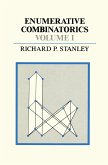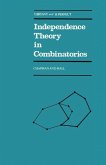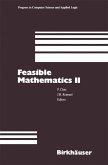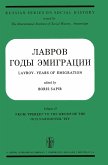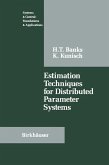- Broschiertes Buch
- Merkliste
- Auf die Merkliste
- Bewerten Bewerten
- Teilen
- Produkt teilen
- Produkterinnerung
- Produkterinnerung
Notwithstanding its title, the reader will not find in this book a systematic account of this huge subject. Certain classical aspects have been passed by, and the true title ought to be "Various questions of elementary combina torial analysis". For instance, we only touch upon the subject of graphs and configurations, but there exists a very extensive and good literature on this subject. For this we refer the reader to the bibliography at the end of the volume. The true beginnings of combinatorial analysis (also called combina tory analysis) coincide with the beginnings of probability theory…mehr
Andere Kunden interessierten sich auch für
![Enumerative Combinatorics Enumerative Combinatorics]() Richard StanleyEnumerative Combinatorics41,99 €
Richard StanleyEnumerative Combinatorics41,99 €![Independence Theory in Combinatorics Independence Theory in Combinatorics]() V. BryantIndependence Theory in Combinatorics41,99 €
V. BryantIndependence Theory in Combinatorics41,99 €![Feasible Mathematics II Feasible Mathematics II]() Feasible Mathematics II41,99 €
Feasible Mathematics II41,99 €![Algebraic and Discrete Mathematical Methods for Modern Biology Algebraic and Discrete Mathematical Methods for Modern Biology]() Algebraic and Discrete Mathematical Methods for Modern Biology145,99 €
Algebraic and Discrete Mathematical Methods for Modern Biology145,99 €![Лавров Годы Эмиграции Лавров Годы Эмиграции]() LavrovЛавров Годы Эмиграции62,99 €
LavrovЛавров Годы Эмиграции62,99 €![TQM in Action: A Practical Approach to Continuous Performance Improvement TQM in Action: A Practical Approach to Continuous Performance Improvement]() John PikeTQM in Action: A Practical Approach to Continuous Performance Improvement187,99 €
John PikeTQM in Action: A Practical Approach to Continuous Performance Improvement187,99 €![Estimation Techniques for Distributed Parameter Systems Estimation Techniques for Distributed Parameter Systems]() H. T. BanksEstimation Techniques for Distributed Parameter Systems41,99 €
H. T. BanksEstimation Techniques for Distributed Parameter Systems41,99 €-
-
-
Notwithstanding its title, the reader will not find in this book a systematic account of this huge subject. Certain classical aspects have been passed by, and the true title ought to be "Various questions of elementary combina torial analysis". For instance, we only touch upon the subject of graphs and configurations, but there exists a very extensive and good literature on this subject. For this we refer the reader to the bibliography at the end of the volume. The true beginnings of combinatorial analysis (also called combina tory analysis) coincide with the beginnings of probability theory in the 17th century. For about two centuries it vanished as an autonomous sub ject. But the advance of statistics, with an ever-increasing demand for configurations as well as the advent and development of computers, have, beyond doubt, contributed to reinstating this subject after such a long period of negligence. For a long time the aim of combinatorial analysis was to count the different ways of arranging objects under given circumstances. Hence, many of the traditional problems of analysis or geometry which are con cerned at a certain moment with finite structures, have a combinatorial character. Today, combinatorial analysis is also relevant to problems of existence, estimation and structuration, like all other parts of mathema tics, but exclusively forjinite sets.
Hinweis: Dieser Artikel kann nur an eine deutsche Lieferadresse ausgeliefert werden.
Hinweis: Dieser Artikel kann nur an eine deutsche Lieferadresse ausgeliefert werden.
Produktdetails
- Produktdetails
- Verlag: Springer / Springer Netherlands
- 1974
- Seitenzahl: 360
- Erscheinungstermin: 6. November 2011
- Englisch
- Abmessung: 235mm x 155mm x 20mm
- Gewicht: 560g
- ISBN-13: 9789401021982
- ISBN-10: 9401021988
- Artikelnr.: 41320801
- Herstellerkennzeichnung Die Herstellerinformationen sind derzeit nicht verfügbar.
- Verlag: Springer / Springer Netherlands
- 1974
- Seitenzahl: 360
- Erscheinungstermin: 6. November 2011
- Englisch
- Abmessung: 235mm x 155mm x 20mm
- Gewicht: 560g
- ISBN-13: 9789401021982
- ISBN-10: 9401021988
- Artikelnr.: 41320801
- Herstellerkennzeichnung Die Herstellerinformationen sind derzeit nicht verfügbar.
I. Vocabulary of Combinatorial Analysis.- 1.1. Subsets of a Set; Operations.- 1.2. Product Sets.- 1.3. Maps.- 1.4. Arrangements, Permutations.- 1.5. Combinations (without repetitions) or Blocks.- 1.6. Binomial Identity.- 1.7. Combinations with Repetitions.- 1.8. Subsets of [n], Random Walk.- 1.9. Subsets of Z/nZ.- 1.10. Divisions and Partitions of a Set; Multinomial Identity.- 1.11. Bound Variables.- 1.12. Formal Series.- 1.13. Generating Functions.- 1.14. List of the Principal Generating Functions.- 1.15. Bracketing Problems.- 1.16. Relations.- 1.17. Graphs.- 1.18. Digraphs; Functions from a Finite Set into Itself.- Supplement and Exercises.- II. Partitions of Integers.- 2.1. Definitions of Partitions of an Integer [n].- 2.2. Generating Functions of p(n) and P(n, m).- 2.3. Conditional Partitions.- 2.4. Ferrers Diagrams.- 2.5. Special Identities; 'Formal' and 'Combinatorial' Proofs.- 2.6. Partitions with Forbidden Summands; Denumerants.- Supplement and Exercises.- III. Identities and Expansions.- 3.1. Expansion of a Product of Sums; Abel Identity.- 3.2. Product of Formal Series; Leibniz Formula.- 3.3. Bell Polynomials.- 3.4. Substitution of One Formal Series into Another; Formula of Faà di Bruno.- 3.5. Logarithmic and Potential Polynomials.- 3.6. Inversion Formulas and Matrix Calculus.- 3.7. Fractionary Iterates of Formal Series.- 3.8. Inversion Formula of Lagrange.- 3.9. Finite Summation Formulas.- Supplement and Exercises.- IV. Sieve Formulas.- 4.1. Number of Elements of a Union or Intersection.- 4.2. The 'problème des rencontres'.- 4.3. The 'problème des ménages'.- 4.4. Boolean Algebra Generated by a System of Subsets.- 4.5. The Method of Rényi for Linear Inequalities.- 4.6. Poincaré Formula.- 4.7. Bonferroni Inequalities.- 4.8. Formulas of Ch.Jordan.- 4.9. Permanents.- Supplement and Exercises.- V. Stirling Numbers.- 5.1. Stirling Numbers of the Second Kind S(n, k) and Partitions of Sets.- 5.2. Generating Functions for S(n, k).- 5.3. Recurrence Relations between the S(n, k).- 5.4. The Number ?(n) of Partitions or Equivalence Relations of a Set with n Elements.- 5.5. Stirling Numbers of the First Kind s(n, k) and their Generating Functions.- 5.6. Recurrence Relations between the s(n, k).- 5.7. The Values of s(n, k).- 5.8. Congruence Problems.- Supplement and Exercises.- VI. Permutations.- 6.1. The Symmetric Group.- 6.2. Counting Problems Related to Decomposition in Cycles; Return to Stirling Numbers of the First Kind.- 6.3. Multipermutations.- 6.4. Inversions of a Permutation of [n].- 6.5. Permutations by Number of Rises; Eulerian Numbers.- 6.6. Groups of Permutations; Cycle Indicator Polynomial; Burnside Theorem.- 6.7. Theorem of Pólya.- Supplement and Exercises.- VII. Examples of Inequalities and Estimates.- 7.1. Convexity and Unimodality of Combinatorial Sequences.- 7.2. Sperner Systems.- 7.3. Asymptotic Study of the Number of Regular Graphs of Order Two on N.- 7.4. Random Permutations.- 7.5. Theorem of Ramsey.- 7.6. Binary (Bicolour) Ramsey Numbers.- 7.7. Squares in Relations.- Supplement and Exercises.- Fundamental Numerical Tables.- Factorials with Their Prime Factor Decomposition.- Binomial Coefficients.- Partitions of Integers.- Bell Polynomials.- Logarithmic Polynomials.- Partially Ordinary Bell polynomials.- Multinomial Coefficients.- Stirling Numbers of the First Kind.- Stirling Numbers of the Second Kind and Exponential Numbers.
I. Vocabulary of Combinatorial Analysis.
1.1. Subsets of a Set; Operations.
1.2. Product Sets.
1.3. Maps.
1.4. Arrangements, Permutations.
1.5. Combinations (without repetitions) or Blocks.
1.6. Binomial Identity.
1.7. Combinations with Repetitions.
1.8. Subsets of [n], Random Walk.
1.9. Subsets of Z/nZ.
1.10. Divisions and Partitions of a Set; Multinomial Identity.
1.11. Bound Variables.
1.12. Formal Series.
1.13. Generating Functions.
1.14. List of the Principal Generating Functions.
1.15. Bracketing Problems.
1.16. Relations.
1.17. Graphs.
1.18. Digraphs; Functions from a Finite Set into Itself.
Supplement and Exercises.
II. Partitions of Integers.
2.1. Definitions of Partitions of an Integer [n].
2.2. Generating Functions of p(n) and P(n, m).
2.3. Conditional Partitions.
2.4. Ferrers Diagrams.
2.5. Special Identities; 'Formal' and 'Combinatorial' Proofs.
2.6. Partitions with Forbidden Summands; Denumerants.
Supplement and Exercises.
III. Identities and Expansions.
3.1. Expansion of a Product of Sums; Abel Identity.
3.2. Product of Formal Series; Leibniz Formula.
3.3. Bell Polynomials.
3.4. Substitution of One Formal Series into Another; Formula of Faà di Bruno.
3.5. Logarithmic and Potential Polynomials.
3.6. Inversion Formulas and Matrix Calculus.
3.7. Fractionary Iterates of Formal Series.
3.8. Inversion Formula of Lagrange.
3.9. Finite Summation Formulas.
Supplement and Exercises.
IV. Sieve Formulas.
4.1. Number of Elements of a Union or Intersection.
4.2. The 'problème des rencontres'.
4.3. The 'problème des ménages'.
4.4. Boolean Algebra Generated by a System of Subsets.
4.5. The Method of Rényi for Linear Inequalities.
4.6. Poincaré Formula.
4.7. Bonferroni Inequalities.
4.8. Formulas of Ch.Jordan.
4.9. Permanents.
Supplement and Exercises.
V. Stirling Numbers.
5.1. Stirling Numbers of the Second Kind S(n, k) and Partitions of Sets.
5.2. Generating Functions for S(n, k).
5.3. Recurrence Relations between the S(n, k).
5.4. The Number ?(n) of Partitions or Equivalence Relations of a Set with n Elements.
5.5. Stirling Numbers of the First Kind s(n, k) and their Generating Functions.
5.6. Recurrence Relations between the s(n, k).
5.7. The Values of s(n, k).
5.8. Congruence Problems.
Supplement and Exercises.
VI. Permutations.
6.1. The Symmetric Group.
6.2. Counting Problems Related to Decomposition in Cycles; Return to Stirling Numbers of the First Kind.
6.3. Multipermutations.
6.4. Inversions of a Permutation of [n].
6.5. Permutations by Number of Rises; Eulerian Numbers.
6.6. Groups of Permutations; Cycle Indicator Polynomial; Burnside Theorem.
6.7. Theorem of Pólya.
Supplement and Exercises.
VII. Examples of Inequalities and Estimates.
7.1. Convexity and Unimodality of Combinatorial Sequences.
7.2. Sperner Systems.
7.3. Asymptotic Study of the Number of Regular Graphs of Order Two on N.
7.4. Random Permutations.
7.5. Theorem of Ramsey.
7.6. Binary (Bicolour) Ramsey Numbers.
7.7. Squares in Relations.
Supplement and Exercises.
Fundamental Numerical Tables.
Factorials with Their Prime Factor Decomposition.
Binomial Coefficients.
Partitions of Integers.
Bell Polynomials.
Logarithmic Polynomials.
Partially Ordinary Bell polynomials.
Multinomial Coefficients.
Stirling Numbers of the First Kind.
Stirling Numbers of the Second Kind and Exponential Numbers.
1.1. Subsets of a Set; Operations.
1.2. Product Sets.
1.3. Maps.
1.4. Arrangements, Permutations.
1.5. Combinations (without repetitions) or Blocks.
1.6. Binomial Identity.
1.7. Combinations with Repetitions.
1.8. Subsets of [n], Random Walk.
1.9. Subsets of Z/nZ.
1.10. Divisions and Partitions of a Set; Multinomial Identity.
1.11. Bound Variables.
1.12. Formal Series.
1.13. Generating Functions.
1.14. List of the Principal Generating Functions.
1.15. Bracketing Problems.
1.16. Relations.
1.17. Graphs.
1.18. Digraphs; Functions from a Finite Set into Itself.
Supplement and Exercises.
II. Partitions of Integers.
2.1. Definitions of Partitions of an Integer [n].
2.2. Generating Functions of p(n) and P(n, m).
2.3. Conditional Partitions.
2.4. Ferrers Diagrams.
2.5. Special Identities; 'Formal' and 'Combinatorial' Proofs.
2.6. Partitions with Forbidden Summands; Denumerants.
Supplement and Exercises.
III. Identities and Expansions.
3.1. Expansion of a Product of Sums; Abel Identity.
3.2. Product of Formal Series; Leibniz Formula.
3.3. Bell Polynomials.
3.4. Substitution of One Formal Series into Another; Formula of Faà di Bruno.
3.5. Logarithmic and Potential Polynomials.
3.6. Inversion Formulas and Matrix Calculus.
3.7. Fractionary Iterates of Formal Series.
3.8. Inversion Formula of Lagrange.
3.9. Finite Summation Formulas.
Supplement and Exercises.
IV. Sieve Formulas.
4.1. Number of Elements of a Union or Intersection.
4.2. The 'problème des rencontres'.
4.3. The 'problème des ménages'.
4.4. Boolean Algebra Generated by a System of Subsets.
4.5. The Method of Rényi for Linear Inequalities.
4.6. Poincaré Formula.
4.7. Bonferroni Inequalities.
4.8. Formulas of Ch.Jordan.
4.9. Permanents.
Supplement and Exercises.
V. Stirling Numbers.
5.1. Stirling Numbers of the Second Kind S(n, k) and Partitions of Sets.
5.2. Generating Functions for S(n, k).
5.3. Recurrence Relations between the S(n, k).
5.4. The Number ?(n) of Partitions or Equivalence Relations of a Set with n Elements.
5.5. Stirling Numbers of the First Kind s(n, k) and their Generating Functions.
5.6. Recurrence Relations between the s(n, k).
5.7. The Values of s(n, k).
5.8. Congruence Problems.
Supplement and Exercises.
VI. Permutations.
6.1. The Symmetric Group.
6.2. Counting Problems Related to Decomposition in Cycles; Return to Stirling Numbers of the First Kind.
6.3. Multipermutations.
6.4. Inversions of a Permutation of [n].
6.5. Permutations by Number of Rises; Eulerian Numbers.
6.6. Groups of Permutations; Cycle Indicator Polynomial; Burnside Theorem.
6.7. Theorem of Pólya.
Supplement and Exercises.
VII. Examples of Inequalities and Estimates.
7.1. Convexity and Unimodality of Combinatorial Sequences.
7.2. Sperner Systems.
7.3. Asymptotic Study of the Number of Regular Graphs of Order Two on N.
7.4. Random Permutations.
7.5. Theorem of Ramsey.
7.6. Binary (Bicolour) Ramsey Numbers.
7.7. Squares in Relations.
Supplement and Exercises.
Fundamental Numerical Tables.
Factorials with Their Prime Factor Decomposition.
Binomial Coefficients.
Partitions of Integers.
Bell Polynomials.
Logarithmic Polynomials.
Partially Ordinary Bell polynomials.
Multinomial Coefficients.
Stirling Numbers of the First Kind.
Stirling Numbers of the Second Kind and Exponential Numbers.
I. Vocabulary of Combinatorial Analysis.- 1.1. Subsets of a Set; Operations.- 1.2. Product Sets.- 1.3. Maps.- 1.4. Arrangements, Permutations.- 1.5. Combinations (without repetitions) or Blocks.- 1.6. Binomial Identity.- 1.7. Combinations with Repetitions.- 1.8. Subsets of [n], Random Walk.- 1.9. Subsets of Z/nZ.- 1.10. Divisions and Partitions of a Set; Multinomial Identity.- 1.11. Bound Variables.- 1.12. Formal Series.- 1.13. Generating Functions.- 1.14. List of the Principal Generating Functions.- 1.15. Bracketing Problems.- 1.16. Relations.- 1.17. Graphs.- 1.18. Digraphs; Functions from a Finite Set into Itself.- Supplement and Exercises.- II. Partitions of Integers.- 2.1. Definitions of Partitions of an Integer [n].- 2.2. Generating Functions of p(n) and P(n, m).- 2.3. Conditional Partitions.- 2.4. Ferrers Diagrams.- 2.5. Special Identities; 'Formal' and 'Combinatorial' Proofs.- 2.6. Partitions with Forbidden Summands; Denumerants.- Supplement and Exercises.- III. Identities and Expansions.- 3.1. Expansion of a Product of Sums; Abel Identity.- 3.2. Product of Formal Series; Leibniz Formula.- 3.3. Bell Polynomials.- 3.4. Substitution of One Formal Series into Another; Formula of Faà di Bruno.- 3.5. Logarithmic and Potential Polynomials.- 3.6. Inversion Formulas and Matrix Calculus.- 3.7. Fractionary Iterates of Formal Series.- 3.8. Inversion Formula of Lagrange.- 3.9. Finite Summation Formulas.- Supplement and Exercises.- IV. Sieve Formulas.- 4.1. Number of Elements of a Union or Intersection.- 4.2. The 'problème des rencontres'.- 4.3. The 'problème des ménages'.- 4.4. Boolean Algebra Generated by a System of Subsets.- 4.5. The Method of Rényi for Linear Inequalities.- 4.6. Poincaré Formula.- 4.7. Bonferroni Inequalities.- 4.8. Formulas of Ch.Jordan.- 4.9. Permanents.- Supplement and Exercises.- V. Stirling Numbers.- 5.1. Stirling Numbers of the Second Kind S(n, k) and Partitions of Sets.- 5.2. Generating Functions for S(n, k).- 5.3. Recurrence Relations between the S(n, k).- 5.4. The Number ?(n) of Partitions or Equivalence Relations of a Set with n Elements.- 5.5. Stirling Numbers of the First Kind s(n, k) and their Generating Functions.- 5.6. Recurrence Relations between the s(n, k).- 5.7. The Values of s(n, k).- 5.8. Congruence Problems.- Supplement and Exercises.- VI. Permutations.- 6.1. The Symmetric Group.- 6.2. Counting Problems Related to Decomposition in Cycles; Return to Stirling Numbers of the First Kind.- 6.3. Multipermutations.- 6.4. Inversions of a Permutation of [n].- 6.5. Permutations by Number of Rises; Eulerian Numbers.- 6.6. Groups of Permutations; Cycle Indicator Polynomial; Burnside Theorem.- 6.7. Theorem of Pólya.- Supplement and Exercises.- VII. Examples of Inequalities and Estimates.- 7.1. Convexity and Unimodality of Combinatorial Sequences.- 7.2. Sperner Systems.- 7.3. Asymptotic Study of the Number of Regular Graphs of Order Two on N.- 7.4. Random Permutations.- 7.5. Theorem of Ramsey.- 7.6. Binary (Bicolour) Ramsey Numbers.- 7.7. Squares in Relations.- Supplement and Exercises.- Fundamental Numerical Tables.- Factorials with Their Prime Factor Decomposition.- Binomial Coefficients.- Partitions of Integers.- Bell Polynomials.- Logarithmic Polynomials.- Partially Ordinary Bell polynomials.- Multinomial Coefficients.- Stirling Numbers of the First Kind.- Stirling Numbers of the Second Kind and Exponential Numbers.
I. Vocabulary of Combinatorial Analysis.
1.1. Subsets of a Set; Operations.
1.2. Product Sets.
1.3. Maps.
1.4. Arrangements, Permutations.
1.5. Combinations (without repetitions) or Blocks.
1.6. Binomial Identity.
1.7. Combinations with Repetitions.
1.8. Subsets of [n], Random Walk.
1.9. Subsets of Z/nZ.
1.10. Divisions and Partitions of a Set; Multinomial Identity.
1.11. Bound Variables.
1.12. Formal Series.
1.13. Generating Functions.
1.14. List of the Principal Generating Functions.
1.15. Bracketing Problems.
1.16. Relations.
1.17. Graphs.
1.18. Digraphs; Functions from a Finite Set into Itself.
Supplement and Exercises.
II. Partitions of Integers.
2.1. Definitions of Partitions of an Integer [n].
2.2. Generating Functions of p(n) and P(n, m).
2.3. Conditional Partitions.
2.4. Ferrers Diagrams.
2.5. Special Identities; 'Formal' and 'Combinatorial' Proofs.
2.6. Partitions with Forbidden Summands; Denumerants.
Supplement and Exercises.
III. Identities and Expansions.
3.1. Expansion of a Product of Sums; Abel Identity.
3.2. Product of Formal Series; Leibniz Formula.
3.3. Bell Polynomials.
3.4. Substitution of One Formal Series into Another; Formula of Faà di Bruno.
3.5. Logarithmic and Potential Polynomials.
3.6. Inversion Formulas and Matrix Calculus.
3.7. Fractionary Iterates of Formal Series.
3.8. Inversion Formula of Lagrange.
3.9. Finite Summation Formulas.
Supplement and Exercises.
IV. Sieve Formulas.
4.1. Number of Elements of a Union or Intersection.
4.2. The 'problème des rencontres'.
4.3. The 'problème des ménages'.
4.4. Boolean Algebra Generated by a System of Subsets.
4.5. The Method of Rényi for Linear Inequalities.
4.6. Poincaré Formula.
4.7. Bonferroni Inequalities.
4.8. Formulas of Ch.Jordan.
4.9. Permanents.
Supplement and Exercises.
V. Stirling Numbers.
5.1. Stirling Numbers of the Second Kind S(n, k) and Partitions of Sets.
5.2. Generating Functions for S(n, k).
5.3. Recurrence Relations between the S(n, k).
5.4. The Number ?(n) of Partitions or Equivalence Relations of a Set with n Elements.
5.5. Stirling Numbers of the First Kind s(n, k) and their Generating Functions.
5.6. Recurrence Relations between the s(n, k).
5.7. The Values of s(n, k).
5.8. Congruence Problems.
Supplement and Exercises.
VI. Permutations.
6.1. The Symmetric Group.
6.2. Counting Problems Related to Decomposition in Cycles; Return to Stirling Numbers of the First Kind.
6.3. Multipermutations.
6.4. Inversions of a Permutation of [n].
6.5. Permutations by Number of Rises; Eulerian Numbers.
6.6. Groups of Permutations; Cycle Indicator Polynomial; Burnside Theorem.
6.7. Theorem of Pólya.
Supplement and Exercises.
VII. Examples of Inequalities and Estimates.
7.1. Convexity and Unimodality of Combinatorial Sequences.
7.2. Sperner Systems.
7.3. Asymptotic Study of the Number of Regular Graphs of Order Two on N.
7.4. Random Permutations.
7.5. Theorem of Ramsey.
7.6. Binary (Bicolour) Ramsey Numbers.
7.7. Squares in Relations.
Supplement and Exercises.
Fundamental Numerical Tables.
Factorials with Their Prime Factor Decomposition.
Binomial Coefficients.
Partitions of Integers.
Bell Polynomials.
Logarithmic Polynomials.
Partially Ordinary Bell polynomials.
Multinomial Coefficients.
Stirling Numbers of the First Kind.
Stirling Numbers of the Second Kind and Exponential Numbers.
1.1. Subsets of a Set; Operations.
1.2. Product Sets.
1.3. Maps.
1.4. Arrangements, Permutations.
1.5. Combinations (without repetitions) or Blocks.
1.6. Binomial Identity.
1.7. Combinations with Repetitions.
1.8. Subsets of [n], Random Walk.
1.9. Subsets of Z/nZ.
1.10. Divisions and Partitions of a Set; Multinomial Identity.
1.11. Bound Variables.
1.12. Formal Series.
1.13. Generating Functions.
1.14. List of the Principal Generating Functions.
1.15. Bracketing Problems.
1.16. Relations.
1.17. Graphs.
1.18. Digraphs; Functions from a Finite Set into Itself.
Supplement and Exercises.
II. Partitions of Integers.
2.1. Definitions of Partitions of an Integer [n].
2.2. Generating Functions of p(n) and P(n, m).
2.3. Conditional Partitions.
2.4. Ferrers Diagrams.
2.5. Special Identities; 'Formal' and 'Combinatorial' Proofs.
2.6. Partitions with Forbidden Summands; Denumerants.
Supplement and Exercises.
III. Identities and Expansions.
3.1. Expansion of a Product of Sums; Abel Identity.
3.2. Product of Formal Series; Leibniz Formula.
3.3. Bell Polynomials.
3.4. Substitution of One Formal Series into Another; Formula of Faà di Bruno.
3.5. Logarithmic and Potential Polynomials.
3.6. Inversion Formulas and Matrix Calculus.
3.7. Fractionary Iterates of Formal Series.
3.8. Inversion Formula of Lagrange.
3.9. Finite Summation Formulas.
Supplement and Exercises.
IV. Sieve Formulas.
4.1. Number of Elements of a Union or Intersection.
4.2. The 'problème des rencontres'.
4.3. The 'problème des ménages'.
4.4. Boolean Algebra Generated by a System of Subsets.
4.5. The Method of Rényi for Linear Inequalities.
4.6. Poincaré Formula.
4.7. Bonferroni Inequalities.
4.8. Formulas of Ch.Jordan.
4.9. Permanents.
Supplement and Exercises.
V. Stirling Numbers.
5.1. Stirling Numbers of the Second Kind S(n, k) and Partitions of Sets.
5.2. Generating Functions for S(n, k).
5.3. Recurrence Relations between the S(n, k).
5.4. The Number ?(n) of Partitions or Equivalence Relations of a Set with n Elements.
5.5. Stirling Numbers of the First Kind s(n, k) and their Generating Functions.
5.6. Recurrence Relations between the s(n, k).
5.7. The Values of s(n, k).
5.8. Congruence Problems.
Supplement and Exercises.
VI. Permutations.
6.1. The Symmetric Group.
6.2. Counting Problems Related to Decomposition in Cycles; Return to Stirling Numbers of the First Kind.
6.3. Multipermutations.
6.4. Inversions of a Permutation of [n].
6.5. Permutations by Number of Rises; Eulerian Numbers.
6.6. Groups of Permutations; Cycle Indicator Polynomial; Burnside Theorem.
6.7. Theorem of Pólya.
Supplement and Exercises.
VII. Examples of Inequalities and Estimates.
7.1. Convexity and Unimodality of Combinatorial Sequences.
7.2. Sperner Systems.
7.3. Asymptotic Study of the Number of Regular Graphs of Order Two on N.
7.4. Random Permutations.
7.5. Theorem of Ramsey.
7.6. Binary (Bicolour) Ramsey Numbers.
7.7. Squares in Relations.
Supplement and Exercises.
Fundamental Numerical Tables.
Factorials with Their Prime Factor Decomposition.
Binomial Coefficients.
Partitions of Integers.
Bell Polynomials.
Logarithmic Polynomials.
Partially Ordinary Bell polynomials.
Multinomial Coefficients.
Stirling Numbers of the First Kind.
Stirling Numbers of the Second Kind and Exponential Numbers.


